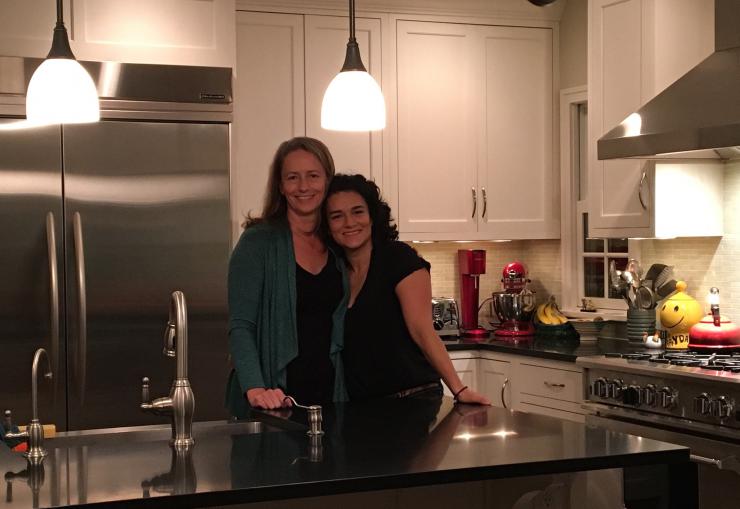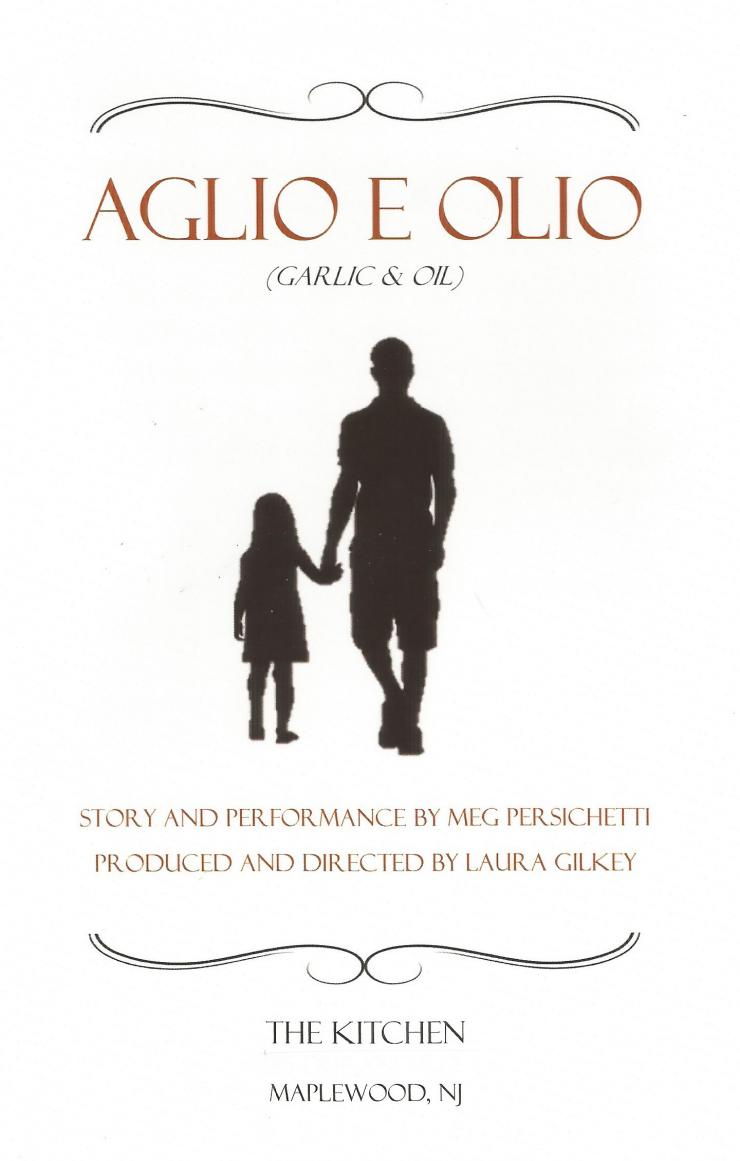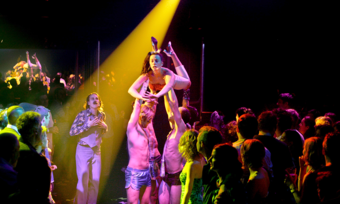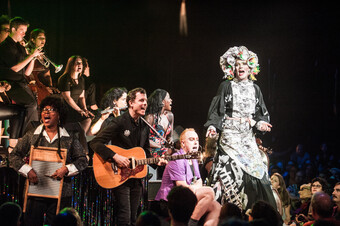Kitchen Theatre
Space for Grief, Community, and Activism
Motivated by my interest in non-traditional theatre’s potential to mobilize social action, I was led to attend Aglio e Olio: a performance categorized by its creators as “kitchen theatre.” The event was invite-only—which I acquired through recommendation from a friend—and took place in the director’s home kitchen. Conceived to give creative, communal space for the writer/performer’s grief over the loss of her father, the invitation gives scant detail beyond the promise of a “multi-sensory experience.” Although the play itself tends closely to its focus on the interrelatedness of food, family, and loss, I found the ingenuity of Aglio e Olio’s approach applicable to challenges many modern activists are facing.
This installation of “kitchen theatre” is written and performed by Meg Persichetti, and produced and directed by Laura Gilkey. Both women are residents of Maplewood, New Jersey: a vibrant creative community and devoted locale that’s unusually hip for a suburb (thirty minutes outside of Manhattan and increasingly populated by Brooklyn transplants). Gilkey’s background is in film, and while Aglio e Olio is her initial directorial foray in live performance, she noted a similarity between the intimacy of kitchen theatre and a film close-up. Likewise, Persichetti observed that the proximity of the audience helped to sustain their attention during breaks from dialogue, and that a traditional stage wouldn’t have been as forgiving.

Upon entering Gilkey’s home, guests are offered drinks while they stand in the foyer. The invitation requests a prompt arrival for start time, but the audience-to-be quickly realizes that they were never let in on the format of the kitchen theatre experience. In close quarters, hesitant but friendly introductions begin to be made. Gilkey is an active participant, curating the informal buzz by way of prompting transition to the performance space when she senses the energy of the guests’ anticipation shift. After the roughly twenty seats have been settled into and brief opening presented, the lights are darkened. The performance itself runs under thirty minutes, during which Persichetti relates the last hours of her father’s life as though to a close friend. Simultaneously, she’s preparing the title recipe (“Aglio e Olio” translates from Italian as “Garlic and Oil”), activating the distinct aroma, sounds, and feeling of home cooking.
To address the unconventional blurriness between commonplace and performance, Persichetti brackets her monologue with slightly-altered versions of Shakespeare’s Prologue and Epilogue from Henry V (which are essentially petitions to the audience’s imagination and openness). This dialogue is deliberately placed to cue the audience to the role they will play in the drama’s realization. I found the choice intriguing, and asked the duo about it in a follow-up conversation the next day. Persichetti explained, “[Shakespeare] did it all the time. [Saying] ‘please, be kind’; ‘suspension of disbelief’; ‘I need as much of your help as possible’—and I realized, god, if he was asking for it, we can ask for it too!” and further that “it’s been done for centuries and… it’s almost a pact you make in the theatre… coming in with an open mind.”
Each step of the recipe becomes a landing place, a moment of respite for both audience and performer as Persichetti deftly maneuvers between the emotional gravity of her monologue and the concrete task of preparing a meal.
Gilkey and Persichetti emphasized the exhaustive revision and rehearsal process invested to establish a sense of congruency between the original story and the Shakespearean inserts, ultimately finding successful integration of the classic work through its “anchor[ing] in domestic activity.” In viewing the performance, I was struck by the demand of exactness that the choreography of real-time cooking required, complete with its potential call to improvisation. Each step of the recipe becomes a landing place, a moment of respite for both audience and performer as Persichetti deftly maneuvers between the emotional gravity of her monologue and the concrete task of preparing a meal.
While Gilkey and Persichetti feel that Aglio e Olio’s application “crosses gender” (no disagreement here), it would be remiss not to acknowledge the power of these two female collaborators. The impressive balance of complex emotional and logistic capabilities, along with the deep-rooted recognizance of a female caretaker placed in the kitchen—an image that could easily have resonated as subjugating trope, but here had the opposite impact—were particularly of note. The comment most recently attributed to seventeenth century Mexican feminist Sor Juana Inés de la Cruz, “One can perfectly well philosophize while cooking supper,” was called to mind for its emphasis on the historically exceptional ranges of female ability. This perspective begins the pivot to my personal interest in the form’s activist potential: I expect Aglio e Olio creators would shy away from the tone implied by “philosophize,” as Gilkey clearly articulated their goal to establish the “poignancy of the mundane” over the sometimes “loftiness of alternative theatre.”

The homegrown, community scale of kitchen theatre has, to my mind, the ability to provide a meaningful service to modern activists. After the election, I attended several gatherings in both New Jersey and Manhattan, where people came together over concerns of the segments of our populous suddenly and urgently placed at greater risk. One particularly rich gathering (which included a true diversity across race, gender, sexual orientation, and religious affiliation) intended to give half of the allotted time for catharsis, and the other half for a strategizing session. Perhaps understandably, emotions swelled in the catharsis, consuming the entire scheduled time. The pain behind every viewpoint was valid, and the need for safe, designated spaces to process grief, anger, and fear became alarmingly evident. Such spaces, where specific traumas can be voiced, validated, and moved through, preempt the efficacy of activist strategy and mobilization. My suggestion is that the kitchen theatre form can play a key role in the provision of these spaces.
The centrality of food to kitchen theatre is unique in comparison to purely visual portrayals in its multisensory engagement. It’s not surprising that Gilkey and Persichetti identified the power of smell in the cooking element to hook audience involvement, as the experience of healing through food is so equivocally human. This highly-relatable dynamic, which came to shape Aglio e Olio’s creative form, has been consistent through Persichetti’s life: she recalls the kitchen as the consistent “meeting place,” and, in adulthood, appreciating “…how it grounded me. How it can be so satiating to have a real meal cooked by somebody who loves you… and I wanted to give that.” Her performance is followed by an invitation for the audience to refresh their drinks and continue the experience through the sharing of food and conversation.
I found the offering of a safe, creative space to give difficult emotion room to breathe touching, aligned with an important aspect of the raison d’être of the arts, and a promising template for extended application.
Between the unusual request of audience socialization before and after, the weight of a performance about the death of a loved one, and the heightened intimacy of a stage within the director’s home kitchen, the question “are we asking too much?” arose frequently in Aglio e Olio’s formulation. Gilkey and Persichetti were gratefully relieved, ten performances later, that their concern proved unfounded (with reiterated acknowledgement of their tireless work to ensure that it “wasn’t overwrought with extraneous details… was siphoned down”). My reaction to the concern of asking too much was: doesn’t life? Admittedly thrown off guard by unexpectedness of the non-traditional elements, I immediately fell into appreciation for its mirroring the unexpectedness of death, trauma, and other challenges life requires us to face. Further, I found the offering of a safe, creative space to give difficult emotion room to breathe touching, aligned with an important aspect of the raison d’être of the arts, and a promising template for extended application.
Kitchen theatre is designed to be reciprocal in its call for vulnerability by audience, performer, and director alike, and its “we’re all in this together” approach is the fulcrum of its success. Circling back to the standout sensory activation of taste and smell, which are intertwined with our connection to memory on a biological level, it’s important to note the trust implicated in such visceral evocation. The roundedness of a communal theatre experience with this level of emotional and physical involvement may seem more intense than one would be initially comfortable with; but the combination of attendance constraint, intimacy of the location, and shared vulnerability may be just the right mixture of ingredients to cultivate local audiences, to elevate the strategies of community activism, and to deepen theatre’s capacity to heal.








Comments
The article is just the start of the conversation—we want to know what you think about this subject, too! HowlRound is a space for knowledge-sharing, and we welcome spirited, thoughtful, and on-topic dialogue. Find our full comments policy here